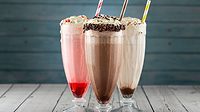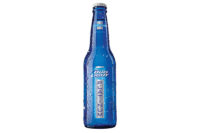Bacardi’s Breakout Year
By JAMIE POPP
Acquisitions, product launches and strong branding
create record results
Coming off a year of
record sales, multiple successful product launches, new packaging and
the acquisition of big-name Grey Goose vodka, Bacardi U.S.A. Inc. is making
headlines around the world. The wholly owned subsidiary of Bacardi Ltd.,
Bacardi USA in Miami is the U.S. import, sales and marketing resource for
its global parent company. The past year has broadened its portfolio, but
rum remains its focus. It just launched Island Breeze, a low-calorie line,
and expects to debut Bacardi Big Apple, a new addition, to prove its
commitment to the high-proof-flavored rum category.
In 1862, Don Facundo Bacardí Massó
founded the brand and La Compañía Bacardi in Cuba. It
liquidated its U.S. assets before Prohibition, and after Prohibition
created its U.S. division in 1944. Since then, Bacardi USA has gone from
being Bacardi Imports Inc. to Bacardi-Martini U.S.A. Inc., after it
acquired Turin’s Martini & Rossi S.p.A. In 1999, the company
officially shortened its name to Bacardi U.S.A. Inc.
The relationship with Martini & Rossi expanded the
company’s portfolio to include wines and spirits, including vermouth.
With brands purchased from Diageo plc in 1998 and its most recent
$2-billion investment in Grey Goose, Bacardi USA is a leading U.S. spirits
marketer.
“Grey Goose has rounded out the Bacardi USA
portfolio and completed a strategic goal for the company,” says
Eduardo Sardiña, president and chief executive officer of Bacardi
USA and Bacardi North America. “The addition of Grey Goose has
allowed Bacardi to be a significant participant in the single largest
segment in distilled spirits. Grey Goose has also become the second most
profitable brand in the Bacardi USA portfolio.”
In addition to the French vodka, Bacardi owns Bombay
Sapphire Gin, Dewar’s White Label and Dewar’s 12 , Cazadores
Blue Agave Tequila, Martini & Rossi Vermouth and Asti, and represents
two premium liqueurs, Disaronno Amaretto and Drambuie. The parent
company, Bacardi Ltd., claims more than 250 brands and labels, but it
retains the title of spirit and rum-market leader with Bacardi, Bacardi
Gold, Bacardi Select, Bacardi 151, Bacardi 8, flavored rums Bacardi
Limón, Bacardi Razz, Bacardi Cóco, Bacardi Vaníla,
Bacardi O, and for the Hispanic market, Bacardi Añejo and Bacardi
Solera.
“Bacardi rum is performing very well as rum
continues to be one of the fastest-growing segments in the spirits
industry. We’re adding a new flavor to our flavored-rum
portfolio,” Sardiña says. “Grey Goose is a great
addition and we expect to continue to drive sales in the United States.
Vodka is the top-selling spirit in the United States, and Grey Goose leads
in the ultra-premium sector of that business.
“Likewise, Bombay Sapphire performs well and has
had an excellent track record under the Bacardi ownership. Sapphire’s
deft marketing program, tied with design, keeps it on the cutting edge with
consumers. We expect The House of Dewar’s to continue to grow in
volume and share, and we see Dewar’s 12 becoming a ‘call
brand.’”
According to Euromonitor International, Bacardi USA
relies heavily on brand recognition and consumer perception of prestige,
especially for its signature rum brands. Bombay Sapphire and Dewar’s,
a blended Scotch, are held in high esteem among American consumers. Using
this to its advantage, Bacardi products are positioned in the market as
high-end premium offerings. But the company also recognizes the importance
of appealing to a broad audience and has its hands in mixers and
malternatives.
In 2002, in conjunction with Anheuser-Busch, the
company decided to expand its beverage line by introducing Bacardi Silver,
the malt-based flavored alcohol beverage that replaced its Bacardi Breezer
line in the United States. It also introduced the highly successful
medium-proof Bacardi Party Drinks line in Zombie, Hurricane, Rum Island
Iced Tea and Bahama Mama flavors.
Bacardi Bottling Corp., Bacardi USA’s only
production facility for Bacardi products in the United States, is located
in Jacksonville, Fla. The site is privy to Bacardi Ltd.’s
Bacardi-Martini Product Development Laboratory, which handles the
company’s global research and development needs, and Bacardi Global
Manufacturing. Needless to say, the Product Development Laboratory prides
itself on product innovation, and Global Manufacturing for packaging
innovation. For example, Island Breeze, was developed in the facility and
will be available in stores in April.
The company’s flagship brand also has undergone
some recent packaging renovations. Instead of two overlapping labels, the
Bacardi signature and 1862 embossing on the front, one label with the Bat
Device logo now appears on every bottle.
Bottling proof
Jacksonville-based Bacardi Bottling Corp. is one of 20
Bacardi production facilities worldwide. It boasts the only and largest
manufacturing site in the U.S., with enough raw ingredients such a fructose
and rum to supply the facility for one month.
High-proof rum is shipped from Puerto Rico and bottled
in Florida, then distributed to centers across the country. Thirteen
varieties of Bacardi products are produced in Jacksonville. Production is
managed in a 225,000-square-foot space, while 80,000 square feet are
dedicated to storing finished goods. Believing in the power of change and
importance of efficiency, the company strives to improve its production
facility every five or six years. Recent renovations include the addition
of a new bottling line and warehouse space.
The company uses six lines to bottle everything from
50 ml. bottles to 750-ml. bottles at 400 bottles per minute, to 1.75-ml.
bottles on a line capable of producing 280 bottles per minute. Plant
employees work four days per week in two 10-hour shifts.
In addition to production and warehouse facility,
Bacardi USA has a distribution center located a few miles from the plant,
which handles imported product, readying it for distribution throughout the
country after it passes through customs at Jacksonville’s port.
“Since the Grey Goose acquisition, all
[imported] products arrive in the off-site distribution center,” says
Sergio Arellano, bottling operations manager.
Going to market
Bacardi says it places a premium on evaluating a
product’s viability. It conducts focus groups, launches new products,
tests the market and evaluates it quickly to avoid going two steps forward
and three steps back. The company also takes steps to make sure a product
is introduced in the proper channel and package to ensure its success.
The company’s global manufacturing group, which
encompasses packaging, quality assurance and production, is housed in the
Jacksonville facility along with the product development laboratory, which
handles the liquid development.
Bacardi recognizes that packaging plays a major role
in a product’s image, and dedicates time and resources to ensure that
bottles reflect what its consumers want and expect. From small details such
as an embossed circle at the base of the neck on all flavored rum bottles
to large components such as Bacardi Limón’s clear label and
indented swirls on Ciclón, Bacardi keeps up with the times.
“Trends are crossing over from one category to
another, especially for high-end categories,” says Yousef Zaatar,
vice president packaging, Bacardi Global Manufacturing. “Consumers
are upgrading. We have liquor bottles that look like perfume. If you look
at the past, the packaging was the lowest component. Over the years we saw
the liquid development become more important, there was no investment in
the package. During the past eight years, that trend has changed and
packaging has become as important as the liquid.”
Fortunately, more packaging standardization across the
Bacardi network has created more synergies and efficiencies. Regardless of
the intricacies of a particular package, a packaging team is responsible
for monitoring any regulatory changes and keeping the product up to date.
“The global packaging team is responsible for
the Bacardi brand globally,” Zaatar says. “So if India, or
Spain, or Mexico wants to develop a new package for Bacardi, the global
packaging department will develop the new package for them. So far
we’ve seen benefits [from increased synergies]. The efficiency and
speed to market is very important to us.”
Regardless of where each new product launches or for
which market it is intended, products destined for an international market
are created within the company’s global product development
divisions. The company’s latest tequila creation, Corzo, which was
released in the U.S. market and soon will be released in Mexico, was
created for future global distribution.
“We build infrastructure for certain products to
build a global product strategically,” Zaatar says.
Getting the finished product on the shelf can require
a number of steps, depending on where the beverage originates. In the case
of Corzo, it is bottled and shipped from Corzo’s production facility
in Arandas, Mexico to Bacardi Bottling Corp.’s distribution warehouse
in Jacksonville, similar to other Bacardi imported products. Distribution
centers receive product in the Midwest, on the East Coast, West Coast and
other strategic locations in the United States, according to Zaatar. The
company doesn’t customize its beverage offerings by region or
country.
Fifty percent of the company’s products are
shipped by rail and 50 percent are handled by common carrier. Electronic
orders from sales staff in Miami are accessed by warehouse employees
through the forklifts used in Jacksonville for scheduled deliveries
throughout 50 states.
“Drivers pick from the order and every pallet
has a barcode,” Arellano says. “They will scan the barcode,
which will tell them if they are picking the right product according to the
order; it also tells [the driver] what to pick in a first-in-first-out
system. Orders from Miami come automatically to Jacksonville.”
The Jacksonville facility handles a small portion of
export orders.
Changing from in-house logistics management with
third-party carriers to a third-party logistics service provider that uses
common carriers, Bacardi Bottling Corp. has reaped the benefits of
increased efficiency. It also uses special software for inventory and
tracking. The logistics provider and software have been important
components in the company’s streamlined operation.
“Customer satisfaction is a big thing at Bacardi
— top-quality products are shipped when they want it [as a result of
improved logistics and technology],” says Bruce Crapse, manager of
logistics and distribution at Bacardi Bottling Corp.
Technology has allowed Bacardi Bottling Corp. to offer
in-time production to many of its customers. Product freshness is paramount
and inventory turns every two to three weeks, according to Crapse. With
less inventory in the warehouse, the facility is able to store more raw
materials from its global suppliers in house.
“We have approximately 70 days supply of glass
on hand, and a 60- to 90-day supply of caps and labels,” says Ron
Nelson, procurement manager at Bacardi Bottling Corp. “We recently
took over storing the glass.” Moving warehouse space for its imports
off-site also increased the storage space that Bacardi Bottling Corp. now
uses for its raw materials.
Consistent quality
Quality control personnel in Jacksonville handle local
quality issues. The team ensures that the first bottle and the 1,000th
bottle meet the same product specifications. The onsite Bacardi Martini
Product Development facility provides a location for testing and tasting
what is being produced, and it serves as an analytical resource for Bacardi
Ltd.
“We have a set of guidelines we have to follow
globally, and we have ‘military’ inspections on every
production line,” says Jennifer Thompson, quality assurance manager
at Bacardi Bottling Corp. “We adhere to those policies and standards.
We have quality assurance inspectors who also make sure we stay within
guidelines.”
Bacardi quality inspections are structured around a
statistical sampling plan used by the military, which is based on volume
and efficiency.
“You know that you have product that is meeting
the standard within a certain confidence level; or you can say
‘we’re willing to accept that 2 percent of the product is
outside of that range based on these results,’ or something to that
effect,” Thompson says.
The division of liquid and package quality control is
apparent throughout the process of creating a new product. For packaging,
there is a dedicated analytical laboratory that handles quality control,
production and new product analytical work as well as research. Close to 25
people work to ensure that packaging leaving the Jacksonville facility
meets global standards. There also is a team dedicated to the quality of
what goes into every bottle and tasters who are instrumental in determining
what is acceptable.
“We have panels of people who test the flavors
to make sure that product is within the tolerance of the specs,”
Zaatar says. “We do all kinds of analysis on the liquid so there is a
profile that is kept on file [that is used by the lab.]
Comparison and triangle tastings are done on a routine
basis for products made in the United States as well as for imported
products. In addition to tasting for quality assurance purposes, there are
a variety of reasons the lab may taste a product.
“Depending on the product, you can have some
shelf-life issues,” Thompson says. “Bacardi Gold and Superior
don’t have flavor ingredients that can degrade over time, so those
don’t have a shelf life. Something that can affect their taste is a
packaging component that may be leaching into the
product, so we make sure, prior to using any packaging component that comes
into contact with the product, that it doesn’t affect the product.
Most of the tasters are trained in house, based on
standards set by the sensory companies with which Bacardi has worked. In
order to maintain tasting consistency, the company calibrates the standards
every two years. Its chemists test the ingredients before they go into the
product and the end result.
Quality assurance personnel on the global side of the
business determine the policies for local quality assurance labs at each
plant. If there is an issue that requires a higher ruling, global quality
assurance steps in to make a decision, according to Zaatar.
“Packaging, purchasing and quality are
structured the same way,” Zaatar says. “There are global groups
for each area [that establish policies and procedures] and local groups
handle the local issues [within the global structure.”
Innovative development
Bacardi Ltd. invests in
product development, which is apparent by the expanding research and
development facility connected to its largest production facility.
“The R&D process is consumer driven,”
Sardiña says. “This is seen by our most recent announcement
for Island Breeze by Bacardi, the original ‘lite’ spirit.
Consumers are asking for more options in their lives, wanting to make smart
choices while enjoying themselves. Our parent company invests strongly
behind research and development, and innovation is key in our
business.”
The onsite laboratory is beneficial to both the global
research and development team as well as production. Analysis is provided
for products that are made in the Jacksonville facility as well as for
imported products. Additionally, other divisions of the Bacardi Ltd.
network use the lab to test samples.
The research center in Jacksonville also provides
assistance to international companies from which Bacardi imports products
in the event there are complaints or concerns about quality.
Distillation, microbiology and wet chemistry are
divided areas in the Jacksonville lab, where one of the most important
instruments is a densitometer, which guarantees a product’s alcohol
proof. The lab tests metal contents in the waters used in all the products
on site as well as fusels and hard fatty acid content and carbohydrates.
The equipment also can determine whether a product has artificial
sweeteners or regular sweeteners present. In addition, an electronic nose
detects scents that a human nose cannot.
“For us, because we introduce quite a few new
products each year, it is very beneficial to have the R&D facility
here,” Thompson says. “It’s difficult to go from a live
batch to full-scale production so it’s very nice having them here so
if there is any problem, they can solve it.”
Premium tequila launch
Designed for the luxury-brand consumer, Corzo tequila
was recently introduced by Bacardi USA. The package, which was designed to
reflect its Mexican roots, and premium quality have impressed patrons in
premier clubs throughout the country.
“Tequila is one of the fastest-growing segments
in the spirits industry, and Americans are ‘trading up,’
wanting luxury items in their lives,” says Eduardo Sardiña,
president and chief executive officer of Bacardi USA and Bacardi North
America. “The product is top quality and also has a stunning
presentation.”
The process of making the concept a reality involves
teams of product and package developers at the R&D facility in
Jacksonville, Fla.
“We have a meeting at the beginning of the
project with the marketing people,” says Yousef Zaatar, vice
president packaging, Bacardi Global Manufacturing. “They come to us;
they initiate the project. Liquid development and packaging development
take place simultaneously. Once the liquid team is satisfied with what has
been produced, the packaging parameters are established.”
Packaged properly
The process of creating the right package for the new
product was no simple task. Zaatar and his global packaging team were
involved from the beginning. Working with an agency that designed the image
and a marketing team that determined the message, he worked on ensuring the
production team could create what was imagined on paper.
“Eventually we had to combine [liquid and
package] because I had to know the characteristics of the liquid so I could
make sure the cork was compatible with the liquid, or the cap was
compatible,” Zaatar says. “I needed to know if there was
treatment on the bottle that might or might not interact with the liquid. I
needed to know if the package needed to be protected from ultraviolet light
or if the liquid was sensitive to oxygen.”
After many tries to create the bottle the designers
and development team had in mind, it was taken to a glass company in
Europe. The package resembles a perfume bottle and “the idea was to
capture the modern art of Mexico,” Zaatar says. Corzo’s package
was created by designer Fabien Baron and features high-end materials and
components, which includes a tie from Japan that is secured around the
opening.
“We used super-premium materials on this
package,” Yousef says.
Available in Silver and Reposado varieties that are
produced in Mexico, the tequila ranges from $44.95 to $54.95 per
750-ml. bottle.




